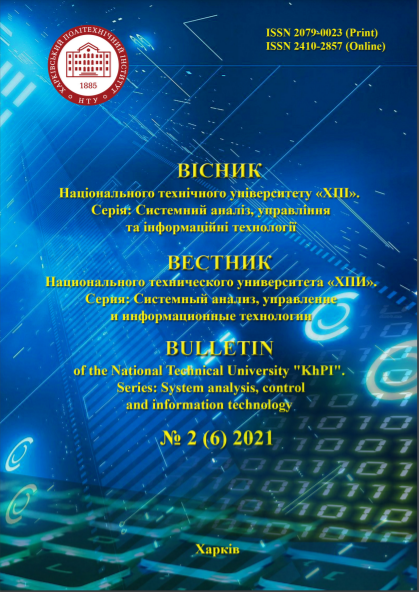THE USE OF ARTIFICIAL INTELLIGENCE METHODS FOR APPROXIMATION OF THE MECHANICAL BEHAVIOR OF RUBBER-LIKE MATERIALS
DOI:
https://doi.org/10.20998/2079-0023.2021.02.15Keywords:
artificial neural network, computer modeling, artificial intelligence, approximation, interpolation, softwareAbstract
In the XXI century, neural networks are widely used in various fields, including computer simulation and mechanics. This popularity is due to the fact
that they give high precision, work fast and have a very wide range of settings. The purpose of creating a software product using elements of artificial
intelligence, for interpolation and approximation of experimental data. The software should work correctly, and yield results with minimal error. The
disadvantage of using mathematical approaches to calculating and predicting hysteresis loops is that they describe unloading rather poorly, thus, we
obtain incorrect data for calculating the stress-strain state of a structure. The solution tool use of elements of artificial intelligence, but rather neural
networks of direct distribution. The neural network of direct distribution has been built and trained in this work. It has been trained with a teacher (a
teacher using the method of reverse error propagation) based on a learning sample of a pre-experiment. Several networks of different structures were
built for testing, which received the same dataset that was not used during the training, but was known from the experiment, thus finding a network
error in the amount of allocated energy and in the mean square deviation. The article describes in detail the mathematical interpretation of neural
networks, the method for training them, the previously conducted experiment, structure of network that was used and its topology, the training method,
preparation of the training sample, and the test sample. As a result of the robots carried out, the software was tested in which an artificial neural
network was used, several types of neural networks with different input data and internal structures were built and tested, the error of their work was
determined, the positive and negative sides of the networks that were used were formed.
References
Milton E. T., James F. B., James E. R., John W. B. FSCBG: An Aerial Spray Dispersion Model for Predicting the Fate of Released Material Behind Aircraft. Environmental Toxicology and Chemistry. 1993, vol. 12, no. 3, pp. 453–464.
Furukawa T., Hoffman M. Accurate cyclic plastic analysis using a neural network material model. Engineering Analysis with Boundary Elements. 2004, vol. 28, issue 3, pp. 195–204.
Elnashai A. S., Ambraseys N. N. Development of Neural Network Based Hysteretic Models for Steel Beam-Column Connections Through Self-Learning Simulation. Journal of Earthquake Engineering. 2007, vol. 11, pp. 453–467.
Kruglov V. V., Borisov V. V. Iskusstvennye nejronnye seti. Teoriya i praktika [Artificial neural networks. Theory and practice]. Moscow, Gorachaia Linia-Telecom Publ., 2002. 382 p.
Shtuchnij nejron [Artificial neuron]. URL: https://uk.wikipedia.org/wiki/%D0%A8%D1%82%D1%83%D1%8 7%D0%BD%D0%B8%D0%B9_%D0%BD%D0%B5%D0%B9%D 1%80%D0%BE%D0%BD (accessed 20.10.2021)
Fogel L., Owens A., Walsh M. Iskusstvennyj intellekt i evolyucionnoe modelirovanie [Artificial intelligence and evolutionary modeling]. Moscow, Mir Publ., 1969. 230 p.
Rosenblatt F. Principy nejrodinamiki. Perceptrony i teoriya mekhanizmov mozga [Principles of Neurodynamics. Perceptrons and the Theory of Brain Mechanisms]. Moscow, Mir Publ., 1965. 480 p.
Chto takoe iskusstvennye nejronnye seti? [What are artificial neural networks?]. URL: https://habrahabr.ru/post/134998 (accessed 20.10.2021)
Algoritm zvorotnogo rozpovsyudzhennya pohibki [Error backpropagation algorithm]. URL: http://www.aiportal.ru/articles/neural-networks/backpropagation.html (accessed 10.10.2021)
Vybor funkcii aktivacii i obuchenie nejronnoj seti [Choice of neural network activation and learning function]. URL: http://monographies.ru/ru/book/section?id=2465 (accessed 22.10.2021)
Larin O., Petrova Yu., Mateichyk V. Two-scale approach to modelling of pneumatic tyres. Systems and means of motor transport. Selected problems. Monographia № 4. Seria: Transport. Rzeszow, Politechnika Pzeszowska Im. Ignacego Lukasiewicza Publ., 2013, pp. 123–128.
Larin O., Barkanov E., Petrova I. Experimental observations of orthotropic elastic and viscoelastic characteristics of the elastomeric textile reinforced composites. Innovative solutions in repair of gas and oil pipelines. Sofia, Bulgarian Society for destructive testing Publishers, BAS Publ., 2016, pp. 192–203.
Downloads
Published
How to Cite
Issue
Section
License
LicenseAuthors who publish with this journal agree to the following terms:
- Authors retain copyright and grant the journal right of first publication with the work simultaneously licensed under a Creative Commons Attribution License that allows others to share the work with an acknowledgement of the work's authorship and initial publication in this journal.
- Authors are able to enter into separate, additional contractual arrangements for the non-exclusive distribution of the journal's published version of the work (e.g., post it to an institutional repository or publish it in a book), with an acknowledgement of its initial publication in this journal.
- Authors are permitted and encouraged to post their work online (e.g., in institutional repositories or on their website) prior to and during the submission process, as it can lead to productive exchanges, as well as earlier and greater citation of published work (See The Effect of Open Access).


